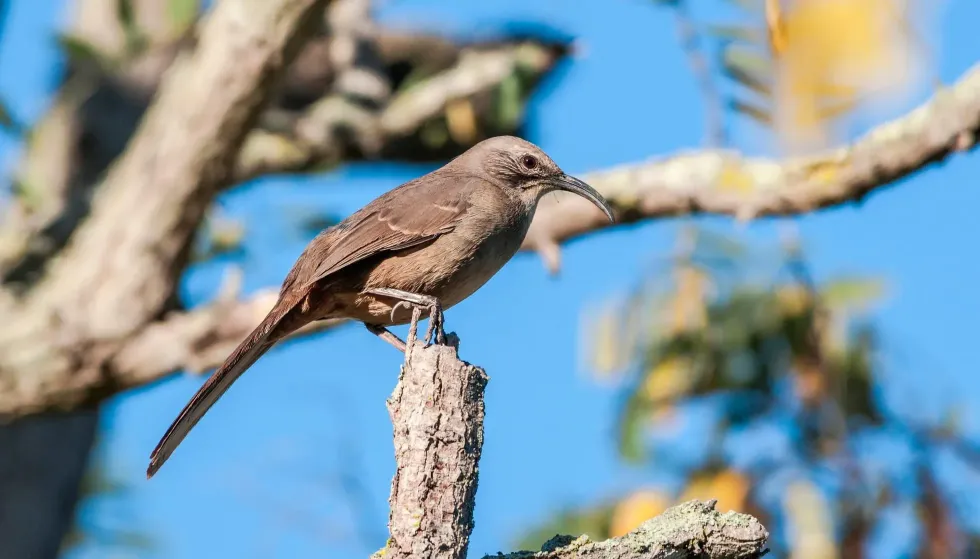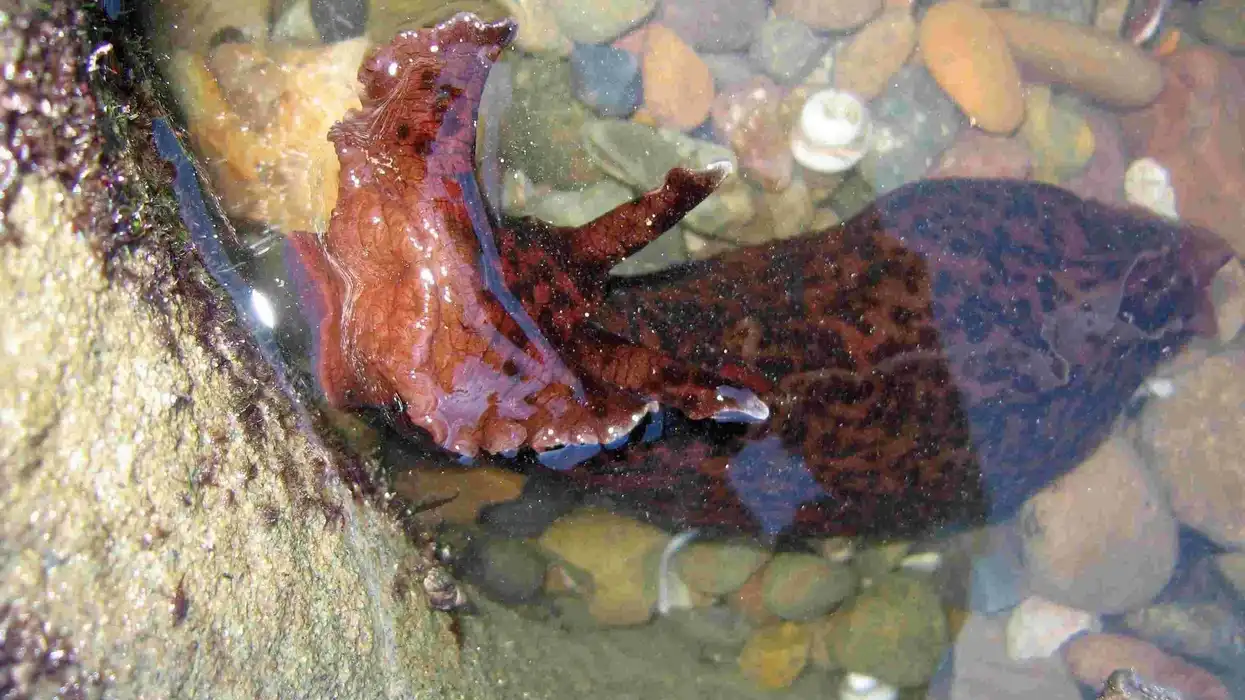The California thrasher is a large, lean, and long tailed songbird endemic to the chaparral shrubs of California and parts of Baja California in western North America. It is the largest species of thrasher bird found in North America, belonging to the order Passeriformes, family Mimidae, and class Aves.
A relative of the northern mocking bird, it is an excellent songster and produces rich musical vocalizations to communicate. The characteristic bird id of the California thrasher is its long tail, lean legs, downward curved bill, and brown feathers.
The bird is a ground forager and uses its bill to forage through leaf litter on the ground for insects and other invertebrates.
It also feeds on seeds, berries, and fruits in the summer months. The California thrasher is the only species of the genus Toxostoma.
These birds form long term bonded monogamous pairs during breeding. Both male and female birds sing from the tops of shrubs and incubate eggs and raise their young ones together. Their population faces threats from urbanization, wildfires, commercial agriculture, and feral cat populations.The conservation status of this bird is Least Concern.
You'll find in this article information about the California thrasher's bill, California thrasher bird guide, California thrasher song, and California thrasher number range.
You may also check out the fact files on sage thrasher and brown thrasher from Kidadl.
California Thrasher Interesting Facts
What type of animal is a California thrasher?
The California thrasher (Toxostoma redivivum) is a species of bird belonging to the order Passeriformes, family Mimidae. It is a large, lanky songbird with a distinctly long tail and a strong downward curved bill. It is a relative of the northern mockingbird and is an excellent songster.
What class of animal does a California thrasher belong to?
The California thrasher (Toxostoma redivivum) is a species of bird belonging to the order Passeriformes, family Mimidae, and class Aves in the Animalia kingdom.
How many California thrasher are there in the world?
It is estimated that the global breeding population of the California thrasher is about 240,000. Endemic to the chaparral of California and northern corners of Baja California, its population has declined due to growing urbanization.
Where does a California thrasher live?
California thrasher birds are endemic to the chaparral habitat of California and parts of Baja California along with the coastal map of California, western North America.
The chaparral habitat consists of shrubs and small trees up to about 13 ft (3.96 m) in height found along the Californian coastline. In the southern part of the chaparral, small numbers of the North American California thrasher live among sage, buckwheat, and coyote underbrush.
In the northern part of the chaparral and at higher elevations, they live in open woodlands of oak, fir, and pine trees.
What is a California thrasher's habitat?
According to the Cornell Lab of Ornithology, the California thrasher is the flagship species of the Californian chaparral or shrubland habitat along with the California coastal map. It inhabits dense or thick shrubs of the chaparral, foothills of mountains, and valley thickets.
In urban areas, California thrasher birds have been spotted in parks and gardens in urban neighborhoods. They are mainly found in the lowland shrub habitats of chaparral that extends into the desert regions of southern California.
Who does the California thrasher live with?
California thrasher birds form long term monogamous bonded pairs.
How long does a California thrasher live?
The California thrasher has an average lifespan of seven years in the wild.
How do they reproduce?
California thrasher birds are oviparous animals and they lay anywhere between one to six eggs in each breeding cycle. Both male and female birds reach sexual maturity after about 228 days from birth and form long term paired bonds.
Both males and females construct the nest about 7-10 ft (2.1-3 m) above the ground in dense shrubs.
The nest is a thick cup or bowl shaped space measuring approximately 10 in (25.4 cm) wide, 5 in (12.7 cm) tall, and 2 in (5.08 cm) deep. California thrashers raise about two broods per year.
Both males and females incubate the eggs and feed the nestlings once they hatch. Young birds leave the nest after about 12-14 days. The male will continue to look after the young ones from the first brood while the female will prepare a nest for the second breeding cycle.
What is their conservation status?
According to the International Union for Conservation of Nature (IUCN 3.0), the conservation status of the California thrasher is of Least Concern. The Cornell Lab of Ornithology lists two sub species of the California thrasher, Toxostoma redivivum and Toxostoma sonomae.
The range and habitat of the California thrasher is threatened by urban development, commercial agriculture and forestry, and climate change related seasonal wildfires. Young California thrasher hatchlings are also prey to feral cats.
California Thrasher Fun Facts
What does the California thrasher look like?
California thrashers are large, lean brown songbirds with a long tail and a downward curved bill. Thrashers are land birds of western North America that forage the ground for food using their downward curved bills and strong lean legs.
The characteristic bird id of the California thrasher is its brown feathered body, white throat, and paler undertail. They have dark cheek patterns, dark eyelines, and dark eyes unlike other similar species of thrashers and mockingbirds.
When foraging on the ground, they move about with their long tails raised and use their curved bills to probe and locate insects and worms.
It is difficult to spot thrashers in the dense shrub of the chaparral. They remain covert in the underbrush but can be identified by their songs and distinct bird id.
How cute are they?
California thrashers are quite cute.
How do they communicate?
The California thrasher communicates using a wide range of calls and songs. This songbird has a rich vocalization comprising warbled and variable phrases that are repeated to produce songs. They use these songs to communicate when mating and breeding, defending their territory, and with their young ones.
How big is a California thrasher?
The California thrasher has an average length of 12-12.6 in (30-32 cm).
How fast can a California thrasher fly?
The flight speed of California thrasher is not recorded.
How much does a California thrasher weigh?
California thrashers weigh about 0.175–0.206 lb (0.078–0.093 kg). Approximately the size of a robin, the California thrasher is larger than a northern mockingbird and smaller than a yellow-billed magpie.
What are the male and female names of the species?
Male and female California thrashers do not have separate names.
What would you call a baby California thrasher?
A baby California thrasher is called a nestling.
What do they eat?
These North American birds are omnivores. They are ground foragers who use their downward curved long bills to toss aside leaf litter and forage through arcs and gaps in the ground for insects.
Their behavior involves looking for ground movement and using their bills to probe for larvae and adult insects, worms, beetles, spiders, caterpillars, millipedes, crickets, moths, wasps, ants, and bees. These birds also feed on fruit and seeds in the summer such as berries, grapes, figs, pomegranates, persimmons, oranges, and bird feed.
Are they dangerous?
These North American birds are not dangerous.
Would they make a good pet?
No, California thrasher birds of North America do not make for good pets. They are covert land birds and ground foragers that thrive in dense thick underbrush and shrubs.
Did you know...
Jean François de Galaup, a French navigator, found the first specimen of the California thrasher in 1786.
The California thrasher is the largest species of thrasher bird.
These North American birds are related to the mocking bird and are excellent songsters. Similar to the northern mockingbird, the California thrasher includes songs of other similar species of birds commonly found in the chaparral habitat in its own song.
The oldest California thrasher on record was about nine years and two months old when it was recaptured and rereleased in California in 2013. It was first captured and banded in 2005.
Is the California thrasher an endemic bird?
Yes, the California thrasher is endemic to the chaparral of California and Baja California. This North American bird is the flagship species of the chaparral or the shrubland plant habitat found along the California coastal map and in the northern corners of Baja California.
What is the color of California thrasher eggs?
Female California thrashers lay between one to six eggs. The eggs are pale blue with pale or dark brown spots. These spots may form a ring around the large end of the egg or may be evenly distributed. The incubation period for California thrasher eggs is 14 days. Both male and female birds incubate the eggs until they hatch.
Here at Kidadl, we have carefully created lots of interesting family friendly animal facts for everyone to discover! Learn more about some other birds from our purple sandpiper facts and shikra facts pages.
You can even occupy yourself at home by coloring in one of our California Thrasher coloring pages.









